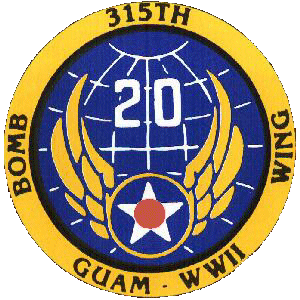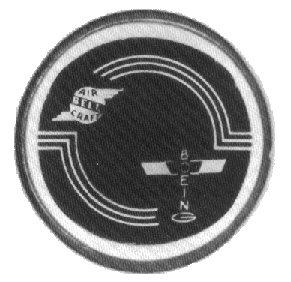
315th Bomb Wing
The following is from the 315th Bomb Wing (VH) history book. It was researched and written by Major Ralph Swann as partial fulfillment of his requirements for graduation from the US Air Force Command and Staff College. It is "Adapted from Air Command and Staff Research Report 862460 entitled A Unit History of the 315th Bomb Wing, 1944-1946."
Make them the biggest, gun them the
heaviest, and fly them the farthest!
--General H. H. Arnold
The B-29, struck by the intense flak, suddenly burst into flames and plummeted out of control toward the ground. The Japanese searchlights had found the B-29 hidden in the night sky, and the antiaircraft batteries quickly inflicted their mortal wound on the American heavy bomber. Captain Kenneth Dougherty, an aircraft commander in another B-29 that night, gave his account of the incident.
At landfall there were four or five planes together. One stayed right with us all the way in. He was slightly ahead at 1 o'clock. We closed in to within a stones throw as we approached the target. In [the] area of [the] IP, search-lights, about 12 of 'em, coned him. Several guns were firing at him and after about 25 bursts, one hit 'em. Bursts were small, black ones. Just as he started to turn left in a steep bank (couldn't tell whether he was hit or taking evasive action) he burst into a sheet of flames in his midsection and he cut across us and went vertically down. We were at 16,000 feet, time 251340Z, three minutes before bombs away. He was out of control, but we did not see him explode. I don't think the ship would have held together in that much fire for very long. Those in back might have gotten out; those in front very doubtful.
Fortunately, it was the squadron's only combat loss for the mission, but Capt Dougherty could only watch as ten comrades-in-arms fell toward earth in their flaming aircraft.
This incident occurred on 25 July 1945 over Tokyo, and the crewmen of the stricken B-29 were members of the 402nd Bomb Squadron, Very Heavy (VH), 502nd Bomb l Group (VH), 315th Bomb Wing (VH). Captain Henry G. Dillingham was the aircraft commander of the ill-fated B-29 that night, and his crew's experience vividly portrays two realities of war. First, their fate is a tragic reminder of the high human costs of armed conflict. Secondly, their actions are a sobering reminder of the dedication and courage of men who have put their lives on the line in the defense of their country. The many brave men, living and dead, like Capt Dillingham and his crew must not be forgotten. To this end, this report provides a written record of the accomplishments of the 315th Bomb Wing.
This study chronicles the history of the 315th Bomb Wing during World War II. Chapter Two covers the unit's activation, training, and deployment to the Pacific Theater of Operation (PTO). Chapter Three emphasizes the combat operations of the 315th during the months it was based in the PTO. Finally, Chapter Four summarizes the significance of the strategic air campaign against Japan and the 315th's contribution to that effort. The history of the 315th Bomb Wing is closely linked to the story of the B-29 aircraft flown by the unit and to the mission of the Twentieth Air Force, the parent unit of the 315th in the PTO. A brief discussion follows to highlight these relationships.
THE AIRCRAFT
General Henry H. Arnold spearheaded the development of the B-29 aircraft. As early as 1939, Gen Arnold pursued the development of a very long-range, very heavy bomber in anticipation of future air power requirements.
Our B-29 idea come to birth in those days when it appeared that England would go down to defeat, and there'd be no place where we might base our planes for future sorties against the Axis powers. Thus a much longer ranged bomber than any we then possessed would be essential to our waging a victorious war.
Gen. Arnold directed the engineering staff at Wright Field, Dayton, Ohio, to design a super bomber and to "make them the biggest, gun them the heaviest, and fly them the farthest!" Several aircraft companies submitted proposals based on the specifications developed by the Wright Field engineers, but Boeing's model 345 was chosen superior. The Army Air Corps gave it the designation XB-29, and Boeing was awarded 3.6 million dollars to start prototype development.
Unfortunately, a long series of failures during the development of the XB-29 threatened to stop plans for full-scale production. The experimental B-29 was plagued by "engine trouble, jammed gears, dead power plants, and fires lurking in the nacelles." Despite the numerous problems and loud outcries from critics of the XB-29 program, Gen Arnold remained steadfast about continued development and full- scale production. In fact, "the bold decision to order mass production of B-29s had been made by Gen Arnold some 16 months before the first test flight, and when that flight was made, 1664 B-29s were already on order." Gen Arnold's persistence paid off on 27 June 1943 when Colonel Leonard "Jake" Harmon successfully flew the second experimental B-29 at Boeing's plant in Wichita, Kansas. Attention then turned to the overwhelming problems of full-scale production.
The Army Air Force and America's aircraft companies cooperated to mass produce the most advanced bomber of World War II. Gen Arnold's challenge to mass produce the B-29 was spurred by President Roosevelt at the Quebec Conference in the fall of 1943. At that conference President Roosevelt pledged 200 B-29s for combat use in Asia by 1 March 1944. It was a staggering promise, but America's aircraft companies worked around-the-clock and met the deadline. Gen Arnold's and the Army Air Force's $3 billion gamble on the B-29 had paid off.
[*The ranks given are those held by the individual at the time of the event being described.]

The B-29 left little room for the pilot and bombardier. Co-Pilot Seat and Controls
"It was the most complex plane ever conceived, 60 tons of fighting fury...four 2,200-horsepower engines...20,000-pound bomb capacity...137,000-pound maximum overall weight with bombs and gasoline... an instrument panel like a mad-man's dream...50,000 separate parts...one million rivets... thousands of miles of complex wiring.. .141 feet wing span...99 feet long...27 feet high...capable of flying a 16- hour mission... dwarfing theB-17 Flying Fortress, all in all, the biggest, fastest, most powerful bomber in the world."
The aircraft that many had written off as a lost cause was finally rolling off the assembly line.
More than the biggest and fastest, the awesome B-29 incorporated many of the latest technological improvements. It was equipped with the newest radar, the APQ-13, and a system of remotely controlled automatic gun turrets known as the central fire-control system (CFC). The CFC had five sighting stations throughout the aircraft which controlled five gun turrets. Four turrets had twin 50-caliber guns while the upper forward turret had four 50-caliber guns. A high-efficiency wing and wing flap system developed by Boeing were also installed, thereby keeping B-29 takeoff and landing ground runs comparable to those for B-17s and B-24s. Its four powerful "2,200 hp, 18 cylinder Wright Cyclone engines with dual sets of turbo-superchargers had four-bladed propellers so large they must be slowed down by 35/100 reduction gears to keep the tip speed under the speed of sound." Finally, the B-29 had a cabin pressurization system designed to maintain a cabin pressure of 8,000 feet for the crew while flying at 30,000 feet. America's first very heavy bomber, the B-29 Superfortress, was ready for aircrews to test it in training and in the special mission that awaited it.
THE MISSION
The creation of the B-29 forced changes in the American military command and control structure in 1944. Many military leaders, including Gen Arnold, recognized the potential power of the B-29 in a concentrated strategic bombardment campaign against Japan. They also realized the B-29 strategic air forces would require a continuity of employment if they were to accomplish their strategic mission. However, "under prevailing doctrines of unity of command, air units were assigned to a theater commander working under broad directives from the Joint or Combined Chiefs of Staff." This meant strategic forces could be diverted to support theater operations at the discretion of the theater commander.
On 10 April 1944, the Joint Chiefs of Staff (JCS) addressed this conflict by adopting a radical new plan to ensure a unified and concentrated strategic bombing effort against Japan. According to the plan, a new strategic air force was created and would remain under the centralized control of the JCS with a single commander. Gen Arnold, acting as their agent to direct worldwide strategic bombing operations. This new strategic air force was designated the Twentieth Air Force. Thus, on 12 April 1944, the Twentieth Air Force became the first unit to be activated with B-29s and operationally controlled by the JCS.

Control Wheel "Horn Button"
Additionally, the JCS established the strategic mission and force composition of the Twentieth Air Force. Its mission reflected the potential strategic power of a concentrated B-29 bombing campaign against Japan.
The primary mission of the Twentieth AF, the first very heavy bombardment organization committed to combat, was to achieve the earliest possible dislocation of the Japanese military, industrial, and economic systems and to undermine the morale of the Japanese people to a point where their capacity to wage war was decisively weakened.
To accomplish its mission, the Twentieth Air Force was authorized a striking force of a thousand B-29s. This powerful force was assigned to two bomber commands, XX Bomber Command and XXI Bomber Command. The XXI Bomber Command was directed to operate out of the Marianas Island in the Pacific with five very heavy bombardment (VHB) wings assigned to it. The 315th Bomb Wing was one of these VHB units.
Back to Introduction
On to Organization and Training
Content ©2003-2004, Larry Miller
ljmiller at charter dot net
August 9, 2005


